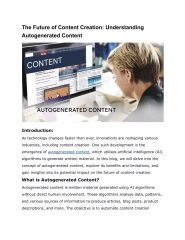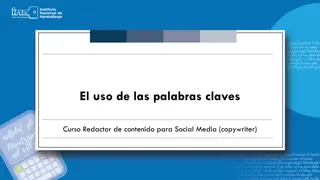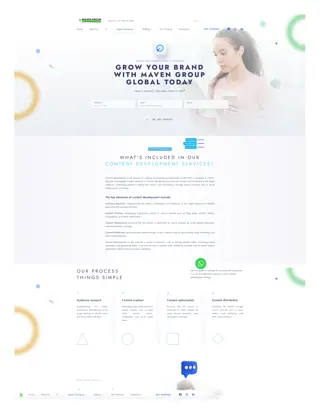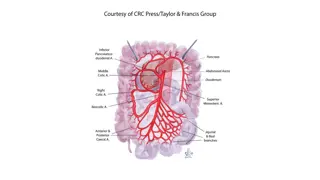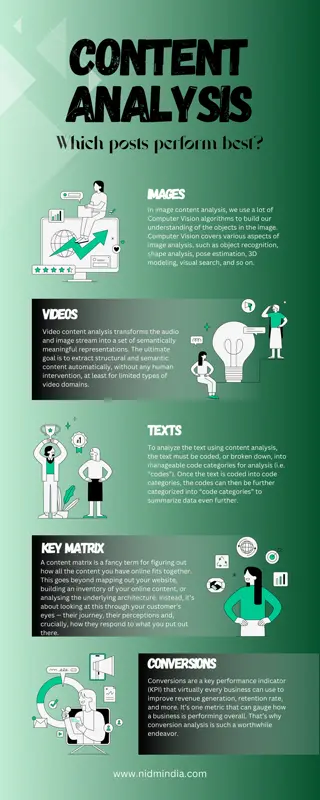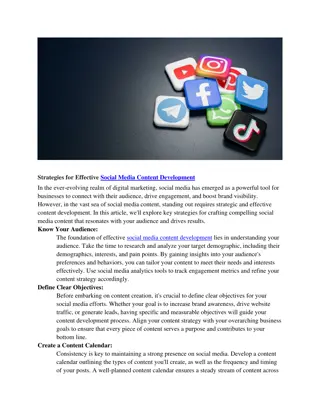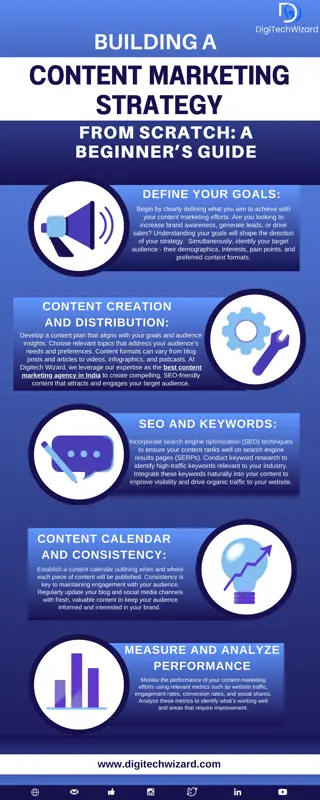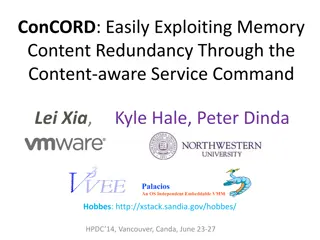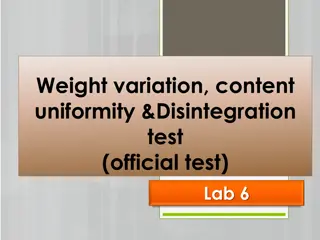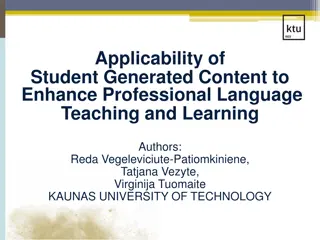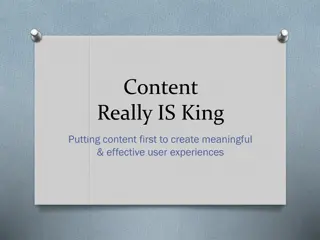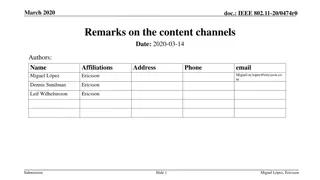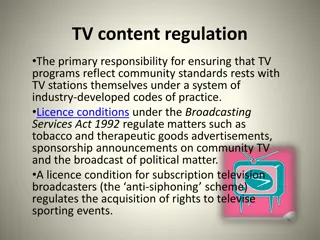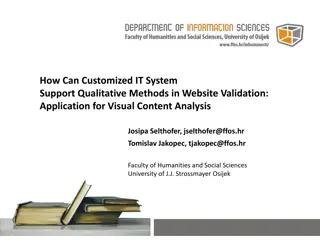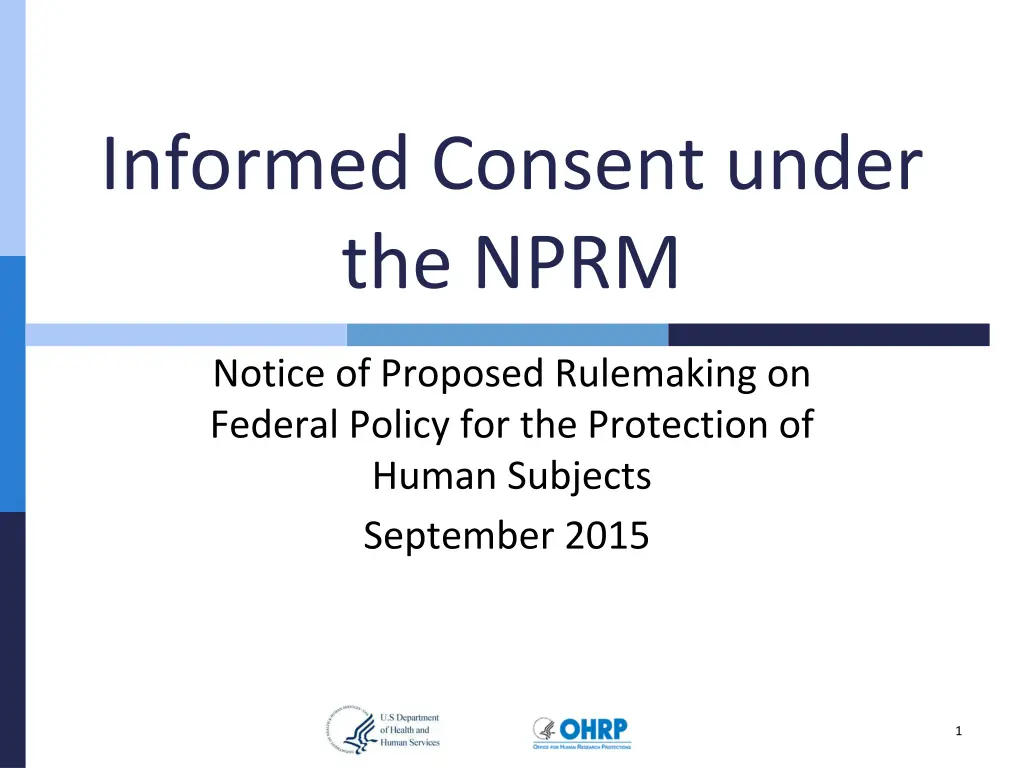
Enhancing Informed Consent for Human Subject Protection
Explore the proposed changes under the NPRM Notice of Proposed Rulemaking to improve the informed consent process for research studies. Discover goals, improvements, and new elements aimed at making consent more transparent and meaningful, with a focus on providing essential information to subjects effectively.
Download Presentation

Please find below an Image/Link to download the presentation.
The content on the website is provided AS IS for your information and personal use only. It may not be sold, licensed, or shared on other websites without obtaining consent from the author. If you encounter any issues during the download, it is possible that the publisher has removed the file from their server.
You are allowed to download the files provided on this website for personal or commercial use, subject to the condition that they are used lawfully. All files are the property of their respective owners.
The content on the website is provided AS IS for your information and personal use only. It may not be sold, licensed, or shared on other websites without obtaining consent from the author.
E N D
Presentation Transcript
Informed Consent under the NPRM Notice of Proposed Rulemaking on Federal Policy for the Protection of Human Subjects September 2015 1
Goals of Informed Consent Changes Make informed consent more meaningful and transparent More informative consent documents and process Implement a posting requirement for informed consent in clinical trials Require informed consent for most secondary research with biospecimens, even when the biospecimens are not identifiable, but through broad consent Change the requirements for waiving consent 2
Improving Informed Consent in General Major revision to introduction of 116 does the following: Emphasizes need to provide essential information a reasonable person would want to know, before providing other supplemental information to the subject 3
Improving Informed Consent in General (2) Major revision to introduction of 116 does the following: The core required information should be in main part of consent form, which should be short Appendices can include any other information that is desired to be given no restrictions on that Goal is to counter current trend to have long consent forms with most important information buried 4
Improving Informed Consent in General (3) Major revision to introduction of 116 does the following: Information must be presented in sufficient detail, and must be organized and presented in a way that facilitates prospective subject s understanding of the reasons why one might or might not want to participate 5
Posting of Clinical Trial Consent Forms For clinical trials: within 60 days of being closed to recruitment, copy of final consent form must be posted on government website One-time requirement 6
New Elements of Informed Consent 116(a)(9): Notice about possible future use of data stripped of identifiers 116(b)(7): Notice about possible commercial profit 116(b)(8): Notice about whether clinically relevant research results will be given to subjects 116(b)(9): Option to allow re-contact 7
Requiring Consent for Secondary Research with De-identified Biospecimens Consent will almost always be needed to conduct secondary research with a biospecimen (e.g., excess blood collected in clinical care), even if de-identified Compare to current rules: de-identified biospecimen not considered a human subject, thus no consent needed This change accomplished by expanding definition of human subject 8
Requiring Consent for Secondary Research with De-identified Biospecimens However, one major category of biospecimens will be excluded from this new requirement could still conduct research, if de-identified, without consent Exclusion: research designed to generate information already known about a person Example: evaluating a new in vitro test for a particular genetic mutation 9
Requiring Consent for Secondary Research with De-identified Biospecimens The new consent requirement could be met by using a new broad consent form to be released by federal government Would allow biospecimen to be stored and used for unspecified future research in contrast with consent for a specific study Storage and use would be exempt if form used 10
Requiring Consent for Secondary Research with De-identified Biospecimens Limited IRB review requirement: likely one-time review per institution of procedures for getting consent forms signed (e.g., not while being admitted to hospital) Goal: both the form and the procedures should be well-designed to genuinely empower subjects If people end up signing forms quickly, without thinking about what it means, that is failure 11
How Does these Proposals Affect Secondary Research with Data? No change to definition of what constitutes identifiable private information it would not be expanded Proposal from ANPRM to implement HIPAA standards is no longer being proposed 12
How Does these Proposals Affect Secondary Research with Data? Core rules relating to secondary research with de- identified data are unchanged: it would still not constitute a human subject, and not be under the regulations Furthermore, new rules relating to biospecimens do not alter rules relating to secondary research with data, regardless of whether data had been obtained from a biospecimen or some other way All data, regardless of source, treated same way 13
How Do these Proposals Affect Secondary Research with Data? In several ways, proposals increase ability to conduct research with identified data without consent, assuming appropriate protections in place While new broad consent forms can be used by researchers to obtain consent for secondary use of identifiable data, that is merely a new option Unlike for biospecimens, there are many other options for data researchers apart from obtaining broad consent 14
How Do these Proposals Affect Secondary Research with Data? Researchers could Use data stripped of identifiers Keep a one-way link to identifiers Obtain IRB waiver allowing use of identifiers Use new exemption allowing use of identifiable data with notice instead of consent Any one of these might be preferable to obtaining broad consent (in contrast to few options for research with biospecimens) 15
New General Waiver Criteria For research involving access to or use of biospecimens or identifiable private information, the IRB must determine that the research could not practicably be carried out without accessing or using identifiers Non-identified information should be used whenever possible in order to respect subject s autonomy. 116(f)(1)(iii) 16
Waiver of Consent Requirements More Stringent for Biospecimens Need compelling scientific reasons for the use of biospecimens Research could not be conducted with other biospecimens from which informed consent was/could be obtained IRBs would not be permitted to waive consent if individuals were asked to provide broad consent and declined Waiver intended to be rare! 17
No IRB Waiver if Refusal of Broad Consent IRB cannot waive consent if individuals were asked, and refused, to provide broad consent to the storage, maintenance and use of biospecimens or identifiable private information Note that this rule may impact whether researchers choose to obtain broad consent for data, versus choosing other options 116(f)(3) 18
Waiver of Signature Requirement Obtaining subject s signature can be waived if: Subjects are members of a distinct community in which signing forms is not the norm Research involves no more than minimal risk , and Alternative mechanism for documenting consent is obtained 117(c)(1)(iii) 19
Elimination of Need for Recruitment Waiver Current rules require IRB consent waiver before obtaining recruitment information Change eliminates the need to waive consent for these activities Requires that data will be protected Harmonizes with FDA rules, which do not require waiver 116(g) 20
Submit Comments! See OHRP Website: http://www.hhs.gov/ohrp 21
OHRP Contact Information Phone: 866-447-4777 Fax: 240-453-6909 E-mail: ohrp@hhs.gov 240-453-6900 22

